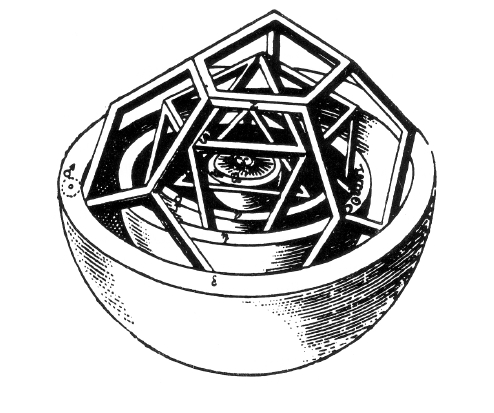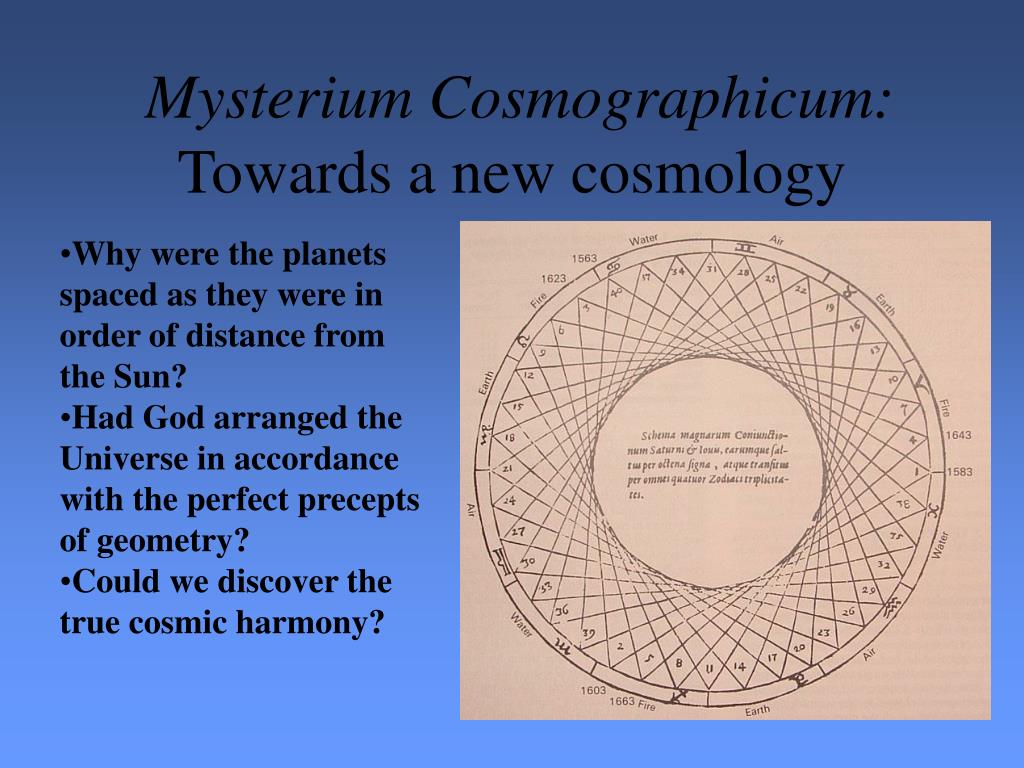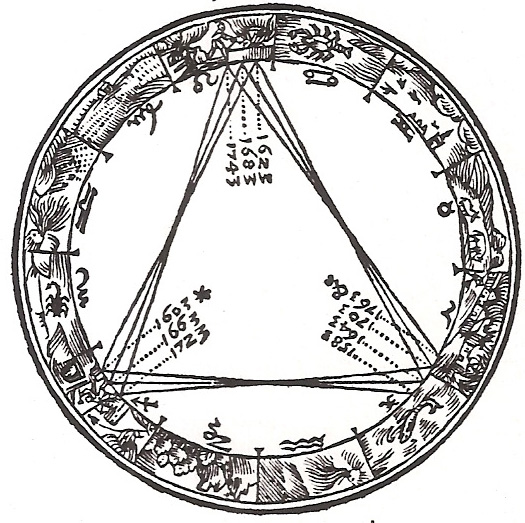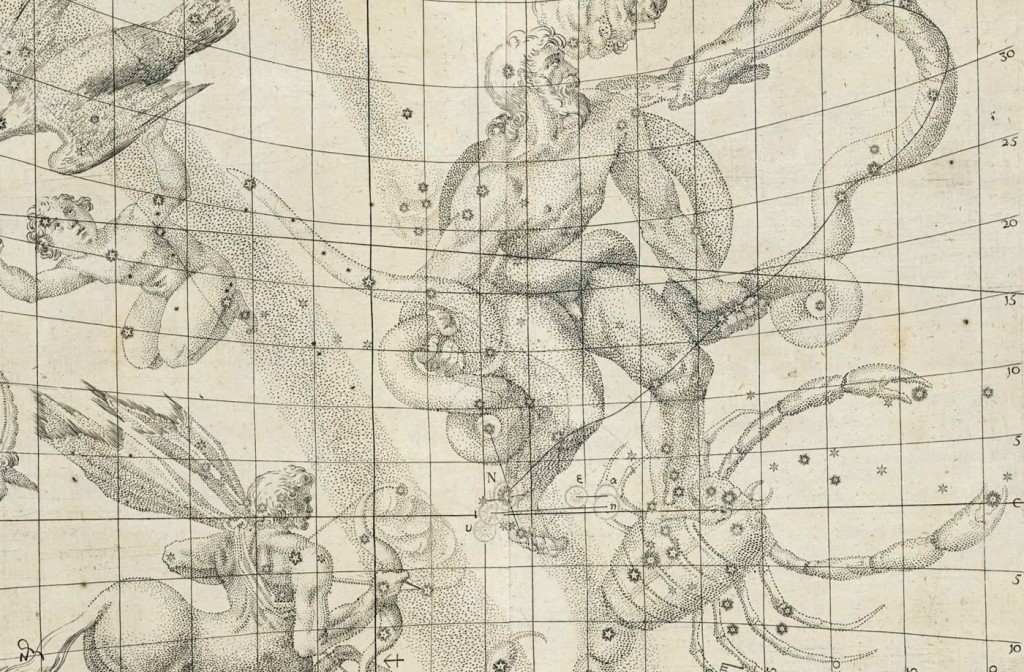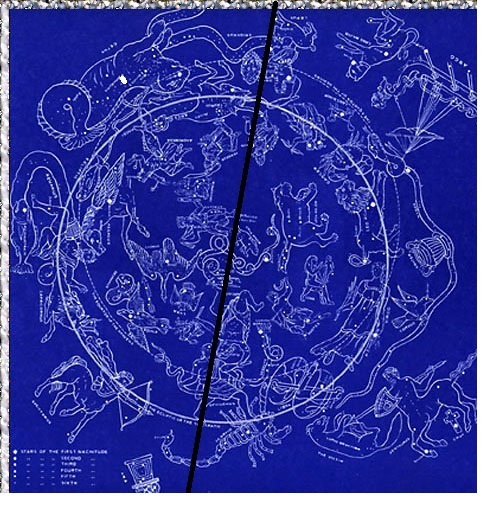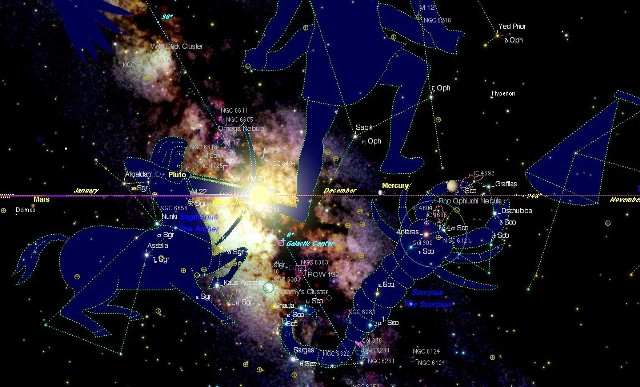
The Celestial Signs of April 2022 and Passover
Welcome to our monthly blog for April, 2022 which brings a month full of celestial signs, including planetary conjunctions, massings and alignments, many taking place in Capricorn during the month that brings us Passover, in recognition of the perfect sacrifice of Jesus Christ. From the opening of this busy month in the sky, the New Moon starts the show on April 1st. Many religious calendars use the New Moon as markers to open the months of their year, the Hebrew being the among the most familiar in Biblical Astronomy. For the Jews, the New Moon ends the month of Adar and starts the Passover month of Nisan which takes place on April 15, this year. April opens with three bright planets massed low in our east-southeast sky just before sunrise. This was preceded by a triangular massing of Venus-Mars-Saturn in Capricornus on March 28th, 2022. In April 2022, these planets Venus, Saturn & Mars are only 6 degrees, apart with Venus to the left, followed by Saturn and then Mars. This was followed three days later according to the U.S. Naval Observatory, in the early dawn on the US east coast, with a close fly-by of Mars and Saturn, as the two approached each other closer than an apparent lunar diameter on April 5th, as seen in Figure 1 below.
Figure 1. Mars-Saturn conjunction in Capricorn on April 5th, 2022. 1

This union of Mars and Saturn, has some interesting implications as Mars can represent blood due to its redness, which is significant during the month of Passover in light of the perfect sinless blood of Christ, that he sacrificed for all humanity. Mars can also represent the Warrior Archangel Michael as he fights for God’s people, against Satan-embodied in Saturn or Satan’s planet. With this conjunction in Capricorn in April, it recalls the same month our Lord was crucified on April 28th, 28 AD, with a planetary conjunction series nearly 2000 years after Christ’s crucifixion, more on this later.
Figure 2. Capricorn the Sacrificial Goat

We find all three planets in the constellation Capricorn, which is very notable with Passover taking place, as these 3 bright planets align in Capricorn–the Mazzaroth sign that combines the Goat with a fish. Bullinger tells us that; “in the Goat we have the atoning sacrifice, while in the fish we have the people for whom atonement is made.”2 The redeemed multitudes seen in Capricorn’s fish-tail, are also embodied in the adjoining decans of Delphinus the dolphin, and Pisces Australis, the southern fish of the water sign Aquarius. 3 As Christ embodies the Passover in Israel, his death and resurrection fulfilled the prophecy of Isa. 53, sacrificing his life for the sheep. As Bullinger eloquently puts it; “the living fish proceeds from the dying goat, and yet they form only one body. [Eph. 4] That picture which has no parallel in nature, has a perfectly true counterpart in Grace, and the great multitude which no man can number, is redeemed unto eternal life through the death of their redeemer. 4
This seems to link to the two miracles of the fish to open, and during the resurrection arrivals of Jesus’ earthly ministry. As nobody is able to number the great multitude of people redeemed by our Lord Jesus Christ, perhaps it is fitting that the 153 fish netted in this miraculous catch, is not only a number in the infinite Lucas Series of numbers, but it also relates to the geometric growth of the Acts church via the infinite ratios of Pi, and Phi. This is Christ building the Temple of his body. [Gen. 15:5]
Starting around the 8th of April, Jupiter, which was immersed below the horizon during the first week of April, makes an appearance expanding this alignment with the other three planets to make it a foursome. By the morning of April 19, all four planets are aligned in a diagonal line of a little over 30 degrees; from lower left to upper right: Jupiter, Venus, Mars and Saturn, as seen in Figure 3.

Passover, kicks off the Feast of Unleavened Bread or Pesach for the Hebrew Year beginning at sundown on Friday, 15 April 2022, and ends, nightfall on Saturday, 23 April 2022. Thus, during the week of the Feast of Unleavened Bread, we find the celestial events, including this planetary alignment in Capricornus following Passover. The predawn sky on April 19, 2022 in Stellarium shows the alignment of Jupiter, Venus, Mars and Saturn. This alignment is preceded by two planetary conjunctions, the first with Jupiter-Neptune in Aquarius on April 12th, and the second on April 18th with Mercury and Uranus in Aries. 6
Since it falls during the Feast of Unleavened Bread, this planetary union of Mercury–Uranus bears a closer look. Mercury-Gabriel is the Messenger archangel who usually brings attention to what he may be introducing. In this case, Uranus is one of the outer planets of the Solar System, and since it was not visible to the naked eye, it does not carry as much press in the Hebrew tradition. However, on April 3rd, 2022, a Lunar occultation of Uranus, occurred which calls our attention, especially when we consider all the other lunar activity taking place with the planets during this time. The idea that the April 18th union of Mercury and Uranus took place in Aries, is also noteworthy, since the celestial chapter of constellations that opened with Capricorn, the dying Goat, closes with Aries the Ram, with life restored via the blood of the Lamb, who takes away the sins of the world, [John 1:29].
Figure 4. The Crescent Moon appears with each of the four aligned planets in Capricorn. 7

The Crescent Moon, looms below Saturn on April 25, Mars on April 26 and finally Jupiter and Venus on April 27. 8 This early morning view of the east-southeast horizon, is greeted the next day with yet another planetary conjunction of Venus and Neptune in Aquarius on April 28th. It is interesting to note that the two planetary unions involving Neptune on the 12th and 28th of April, not only bracket the Mercury-Uranus union on the 18th, but also all the lunar snapshots with each of the 4 aligned planets!
At a glance, we find the three brightest denizens of the night sky: a 12% lit Crescent Moon, Jupiter 4 degrees top left, and Venus suspended 5 degrees over the slice of lunar light. Venus and Jupiter are separated by 3.2 degrees on the 27th, but only 2 degrees on April 28th, and 1.3 degrees on April 29th. On April 30-May 1, Venus and Jupiter stand together, separated by only .5 a degree in North America. 9 This event occurs during the final week of April with the approaching union of the King Planet Jupiter and Venus, the bright and Morning Star, in Capricornus.
Figure 5. This is the closest Venus-Jupiter conjunction since August 2016. (Image credit: Stellarium) 10

The Hebrew name for Capricornus is Gedi–the kid or cut off, the same as the Arabic Al Gedi. In Figure 6 below from Robert Wadsworth, we find the star of this name-Algedi in the goat’s horn, with a second star in the goat’s–fish’s tail, named Deneb Algedi. This exhibits the unity of the Goat’s sacrificial atonement with the faithful of the spiritual body of his future church, both Jew and Gentile. Many times in Biblical Astronomy the King planet Jupiter plays a key role, as during this time in 28 AD, when we find the King planet in Capricornus, as Jesus finished his earthly ministry. On April 24th, 28 AD, Jupiter was in conjunction with the star Deneb Al Gedi in the fish-tail of Capricornus, as Jesus‘ rulership over the redeemed multitudes seen in Capricorn’s fish-tail, is evident with the Jupiter-Deneb Algedi conjunction in Fig. 6, mirroring the Jupiter conjunction with Venus in Capricorn at the end of April, 2022.
Figure 6. Jupiter-Deneb Algedi conjunction seen from Jerusalem on April 24, 28 A.D. 11

A key related point with this April 24th sign in Capricornus is this day on the Hebrew calendar was Aviv 10, also the day the Passover Lambs were selected, [Ex. 12:3]. Another meaning of Deneb Al Gedi is the sacrifice comes, which fits since this same day, on Aviv 10 Jesus entered Jerusalem riding a donkey as the perfect sacrifice to redeem all mankind, [Matt. 21:1-11, Zech. 9:9]. 12
Another celestial sign related to Jesus’ Crucifixion involved the Southern Cross.
According to the writings of Richard Hinckley Allen (1838-1908), an expert in stellar nomenclature, the Southern Cross was last seen on Jerusalem’s horizon at 31 degrees 46′ 45″ about the time that Christ was crucified. 13 But due to the Precession of the Equinoxes, a spiraling motion of the Earth’s axis-the Southern Cross shifted out of view further south over the ensuing centuries. The Hebrew name for the Southern Cross is Adom, which means the cutting off, from the prophecy of Dan. 9:26, referencing that the Messiah shall be “cut off.” This corresponds exactly to the Hebrew name for Capricornus as Gedi–the kid or cut off, that we saw above in the meaning of the star Gedi. E.W. Bullinger again enlightens us regarding the last letter of the Hebrew alphabet — TAU, which was anciently made in the form of a Cross. 14
Aben Ezra gives the Hebrew name too, of the Southern Cross as Adom, which means “cutting off,” as the angel told Daniel of the “cutting off of the Messiah.” And Christ was cut off by being condemned and crucified.”
Joseph Seiss, in his book on the Gospel in the Stars affirms that “the Southern Cross was visible on the horizon of Jerusalem about the time that Christ was crucified. It consists of four bright stars placed in the form of a cross, and is by far the brighest star-group in the southern heavens. Standing directly in the path of the second Decan of Virgo, the double-natured Seed of the woman, and connecting with Libra the price of redemption, it takes the same place in the celestial signs that the Cross of Calvary holds in the Christian system.” 15
Figure 6. The Decan of the Southern Cross. 16
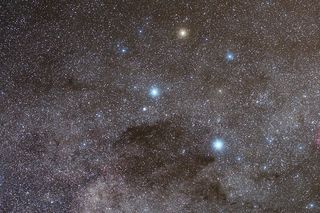
Bullinger discusses how this sign has lost its original meaning of; “It is Finished,” which was Jesus’ last declaration on the Cross at Calgary. As our Lord’s dying declaration, as he gave up his life, for truly none could take it from him, he gave up his “physical” life of the flesh, to obtain eternal life for us all. Christ’s atoning work of redemption is utterly complete and finished when Jesus declared it so. The decan of the Southern Cross is also pictured below in Fig. 7, with Centaurus.
Figure 7. Centaurus with the Southern Cross below Centaurus. 17

The Hebrew name for this constellation Bezeh-means despised, which is found in Isa. 53:3; He is despised and rejected of men. The brightest star in the horse’s foreleg; Toliman means the heretofore and the hereafter, marking him as the one which is, which was and which is to come. Sir John Herschell observed this star rapidly growing brighter, making it a possible variable star. 18
From Bob Wadsworth, our late brother in his Biblical Astronomy Newsletter, provided some key historical details on the visibility of the Southern Cross. He showed the “highest position of the Southern Cross seen from Jerusalem in 1000 B.C. At this time, the upper star of the Crux was 17 degrees above the horizon, and the lower star 11 degrees above the horizon. The whole cross was quite visible from Jerusalem around the time of King David.” 19 This links the genealogy of David to Christ through the royal line of Judah.
Wadsworth includes the coordinates of the Southern Cross, seen from Jerusalem on the day of Christ’s Crucifixion as follows; [Newsletter graphics shows] the highest position of the Southern Cross as seen from Jerusalem on April 28, 28 A.D., or the date of the Lord’s crucifixion. The upper star of the Crux was a little over 12 degrees above the horizon, and the lower star was a little over 6 degrees above the horizon. It is most difficult to say if the lower star was visible through atmospheric haze at that time. But it is safe to say that the lower star most likely disappeared from the Jerusalem skies some point between the time of the Lord’s crucifixion and 155 AD, when it was 5 degrees above the horizon at its highest position. Newsletter graphics shows the highest position of the Southern Cross in the year 1000 A.D. Here the upper star is about 6 degrees above the horizon, and the lower star is near 0 degrees. The upper star most likely disappeared from the Jerusalem skies sometime between this date and 1240 A.D., when the upper star was 5 degrees above the horizon at its highest point. This was during the time of the Crusades. 20
The Astronomer Bayer drew the Southern Cross over the hind legs of the Centaur, giving it in his text as moderis crux Ptolemaeo pedes Centauri.” He goes on to say that “it seems remarkable that it was only outlined over the Centaur in the Flamsteed Atlas.” 21
This is unlike the way it is pictured above in Fig. 7, but closer to the way it is found today in the southern hemisphere. Of special interest to our faithful brethren “down under” where autumn is approaching, and the Sun is setting earlier in the southern hemisphere, sunset was at about 6:48 p.m. on April 1, and in Melbourne, Australia it’s at 7:14 p.m. local time. In mid-southern latitudes, by 8:00 p.m. when it is fully dark the Southern Cross was high in the southeastern sky from Melbourne; it is about 40 degrees above the horizon on April 1 (the new moon there occurs at 5:24 p.m. local time on April 1st). The Southern Cross will be above Centaurus, near Alpha Centauri (Rigil Kentaurus). 22
Perhaps our intrepid Michael Toms and some of his “mates” can take a picture of the Southern Cross, and post it on the Biblical Astronomy Fellowship Page, with their observations for the rest of us in the Northern Hemisphere? I also want to acknowledge and thank Joseph Damien Cooper for first alerting me to the celestial activity this month, which I’m very thankful for. I can’t always be on top of all the celestial happenings, and the help of wonderful & faithful believers like Joseph, is always much appreciated. He is a great example of how we are the spiritual body of Christ, and we work together to bless each other!
I believe the visible appearance on the horizon from Jerusalem, of the Southern Cross at the time of Christ’s crucifixion, far from chance, served multiple purposes of edification. First, it confirms the Celestial Gospel, reflecting Jesus’ brutal sacrifice on the Cross at Calvary, in a stellar prophecy of the finished work, represented in the last letter of the Hebrew alphabet – TAU, made in the form of a Cross. A trait of the Gospel in the Stars shows the Creator’s hand in not only forming and making the stars in the skies of the heavens, as a precise timepiece, but also naming and numbering the stars according to His purposes; [Gen. 1:14-19, Ps. 147:4, Isa. 40:26]. This also links the Gospel in the Stars-God’s Word written in the Heavens inseparably with written Scripture. The entire record of OT Scriptural Messianic prophecies of his long-awaited ministry being confirmed, not only in Christ’s birth, ministry, resurrection and Ascension, also confirmed beyond a shadow of doubt in the Gospel of the Stars.
As we recognize Passover and Resurrection Saturday, we certainly have much to consider as we honor and praise our Lord Jesus Christ and his unmatched work of redemption, that freed us from our bondage of the flesh, even as the Jews were freed from their bondage at Passover. As we ever rise above the darkness of this world as the super–conqueror we have been made in Christ, this is the only kind of “made man” with eternal rewards.
In Joyful Rejoicing-God Bless!
Agape’ Rene’
Footnotes
1. https://www.space.com/april-2022-morning-planets-jupiter-saturn-venus-mars
2. Witness of the Stars, E.W. Bullinger, p. 75
3. IBID, Footnote p. 75
4. IBID, ppg. 76-77.
5. Figure 3 picture credit; Stellarium
6. https://www.space.com/april-2022-morning-planets-jupiter-saturn-venus-mars
7. IBID, Figure 4 picture credit; Stellarium
8. https://www.space.com/april-2022-morning-planets-jupiter-saturn-venus-mars
9. IBID
10. Figure 5 picture credit; Stellarium
11. Figure 6 picture credit; Biblical Astronomy Newsletter, Bob Wadsworth.
12. Biblical Astronomy Newsletter, Bob Wadsworth.
13. Star Names their Lore and Meaning, p. 185, R.A. Allen.
14. Witness of the Stars, E.W. Bullinger, ppg. 48-50.
15. Gospel in the Stars, Joseph Seiss
16. Fig. 6. picture credit: https://www.space.com/29445-southern-cross-constellation-skywatching.html
17. Witness of the Stars, E.W. Bullinger, p. 40 Figure 7 picture credit on the Centaur with Southern Cross.
18. IBID
19. Biblical Astronomy Newsletter, March/April 1999, Bob Wadsworth
20. IBID
21. Star Names their Lore and Meaning, p. 185, R.A. Allen.
22. https://www.space.com/april-2022-morning-planets-jupiter-saturn-venus-mars







